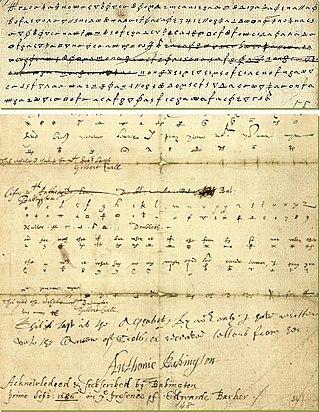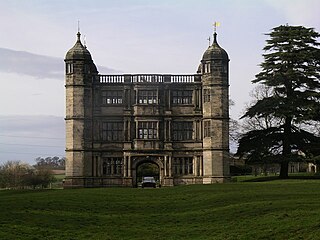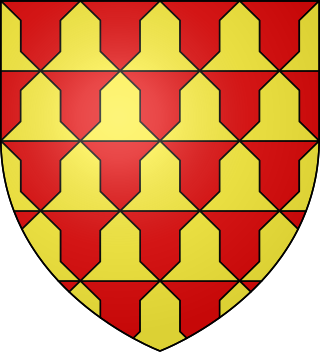
The Babington Plot was a plan in 1586 to assassinate Queen Elizabeth I, a Protestant, and put Mary, Queen of Scots, her Catholic cousin, on the English throne. It led to Mary's execution, a result of a letter sent by Mary in which she consented to the assassination of Elizabeth.

Tutbury is a village and civil parish in Staffordshire, England. It is 4 miles (6.4 km) north of Burton upon Trent and 20 miles (32 km) south of the Peak District. The village has a population of about 3,076 residents. It adjoins Hatton to the north on the Staffordshire–Derbyshire border.

Sir Amias Paulet of Hinton St. George, Somerset, was an English diplomat, Governor of Jersey, and the gaoler for a period of Mary, Queen of Scots.

William III de Ferrers, 5th Earl of Derby of Chartley Castle in Staffordshire, was an English nobleman and major landowner, unable through illness to take much part in national affairs. From his two marriages, he left numerous children who married into noble and royal families of England, France, Scotland and Wales.

Tutbury Castle is a largely ruined medieval castle at Tutbury, Staffordshire, England, in the ownership of the Duchy of Lancaster and hence currently of King Charles III. It is a Scheduled Ancient Monument. People who have stayed in the castle include Eleanor of Aquitaine and Mary, Queen of Scots, who was a prisoner there.

Sir William Wade was an English statesman and diplomat, and Lieutenant of the Tower of London.

Ranulf de Blondeville, 6th Earl of Chester and 1st Earl of Lincoln, known in some references as the 4th Earl of Chester, was one of the "old school" of Anglo-Norman barons whose loyalty to the Angevin dynasty was consistent but contingent on the receipt of lucrative favours. He has been described as "almost the last relic of the great feudal aristocracy of the Conquest".
Gilbert Gifford was a double agent who worked for Sir Francis Walsingham and played a role in the uncovering of the Babington Plot. Shortly before his death in Paris, he was ordained as a Catholic priest in Rheims. His true allegiances, whether to Queen Elizabeth I or to Mary, Queen of Scots, and the Catholic cause – are unclear.

Tixall Gatehouse is a 16th-century gatehouse situated at Tixall, near Stafford, Staffordshire and is all that remains of Tixall Hall which was demolished in 1927. The gatehouse is a Grade I listed building. Tixall was used as a prison for Mary, Queen of Scots for two weeks in 1586.

Robert de Ferrers, 6th Earl of Derby (1239–1279) was an English nobleman.

Sir Hugh Paulet of Hinton St George in Somerset, was an English military commander and Governor of Jersey.

Bastian Pagez was a French servant and musician at the court of Mary, Queen of Scots. He devised part of the entertainment at the baptism of Prince James at Stirling Castle in 1566. When Mary was exiled in England, Bastian and his family continued in her service. The 19th-century historian Agnes Strickland considered his court role as equivalent to the English Master of the Revels; in England he was Mary's chamber valet and designed her embroidery patterns.

Jane, Janet, or Jean Kennedy was a companion of Mary, Queen of Scots, during her captivity in England.

Sir Henry Cavendish (1550–1616) was the eldest son of the Tudor courtier William Cavendish, and Elizabeth Talbot, Countess of Shrewsbury, known as "Bess of Hardwick". He served in the Netherlands as a captain in 1578, and was the MP for Derbyshire five times, but did not participate greatly in politics. Cavendish was also a notorious libertine, and was disinherited by his mother, who held his wardship after his father's death. After his mother's death in 1608 Cavendish inherited the Chatsworth estate, but he sold it to his brother William, who later became the 1st Earl of Devonshire, in the following year. He had a number of illegitimate children, but no legitimate heirs.
Andrew Melville of Garvock was a Scottish courtier and servant of Mary, Queen of Scots.

The Ferrers family were a noble Anglo-Norman family that crossed to England with the Norman Conquest and gave rise to a line that would hold the Earldom of Derby for six generations before losing it in rebellion. They also gave rise to several lines that held English peerages, the longest-living going extinct in the male line in the 15th century, as well as a Norman branch of the family that persisted into the 13th century. A French line persisted into the 16th century.

Elizabeth or Bess Pierrepont (1568–1648) was a gentlewoman in household of Mary, Queen of Scots. Mary hoped that she could be trained to join the household of Queen Elizabeth, and prevented her marrying as her father wished.
Gilbert Curle or Curll was a Scottish secretary who served Mary, Queen of Scots during her captivity in England. He married Barbara Mowbray, one of three sisters serving Mary.
Dominique Bourgoing was a French physician in the household of Mary, Queen of Scots. He is notable as the author of an influential account of Mary's captivity and execution.

Jérôme Pasquier was a French servant of Mary, Queen of Scots, involved in writing and deciphering coded letters.

















